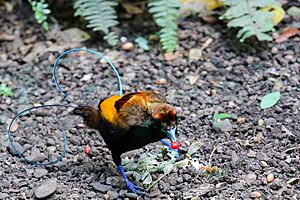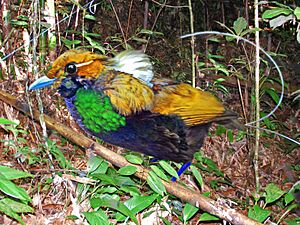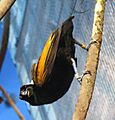Magnificent bird-of-paradise facts for kids
Quick facts for kids Magnificent bird-of-paradise |
|
|---|---|
 |
|
| Male | |
| Conservation status | |
| Scientific classification | |
| Genus: |
Diphyllodes
|
| Species: |
magnificus
|
| Synonyms | |
|
Cicinnurus magnificus |
|
The magnificent bird-of-paradise (Diphyllodes magnificus) is a beautiful bird-of-paradise species. These birds are not considered to be in danger. They are listed as "Least Concern" on the IUCN Red List, which tracks threatened species. They are also protected under CITES Appendix II, meaning their trade is controlled to prevent them from becoming endangered.
Contents
What's in a Name?
The scientific name Cicinnurus means "curled tail." The word magnificus means "magnificent" or "splendid." This perfectly describes these amazing birds! They used to be in a different group called Diphyllodes. This name means "Double leaf-like," which referred to their unique tail feathers.
Family Tree
The magnificent bird-of-paradise belongs to the same group as the King and Wilson's Birds-of-paradise. It is most closely related to Wilson's bird-of-paradise.
There are three main types, or subspecies, of the magnificent bird-of-paradise:
- D. m. magnificus (Pennant, 1781) – Found on Salawati Island and in the western part of New Guinea.
- D. m. chrysopterus Elliot, DG, 1873 – Lives on Yapen Island and in central-west New Guinea.
- D. m. hunsteini Meyer, AB, 1886 – Found in eastern and southeastern New Guinea.
Where They Live
These birds are quite common. They live across a large area in Indonesia, New Guinea, and the islands nearby. You can find them in tropical and subtropical forests. They prefer living on mountains and hills. They usually live at heights of about 1,500 meters (about 4,900 feet). Sometimes, they can be found even higher, around 1,780 meters (about 5,800 feet).
Appearance
The magnificent bird-of-paradise has one of the most amazing feather patterns. They grow to about 26 to 26.5 centimeters (about 10 inches) long. Their body is around 19 centimeters (about 7.5 inches) long.
Male Birds
The male is truly spectacular! He has bright golden-yellow wings. Over his wings, he has a sulfur-colored "cape" that looks almost white. Underneath this cape, there are deep red feathers outlined in black. These feathers form a half-circle over his wings. He also has some brownish feathers on the sides of his cape.
His head is quite short. The top of his head has a light brown, scalloped pattern. This pattern goes down to the back of his neck. His face and chin are a darker reddish-brown. He has a pale grey-blue beak and dark brown eyes. A thin white line runs behind his eyes.
Below, the male has a large, shiny green chest shield. This shield is covered with tiny, scale-like feathers. These feathers shimmer with lime-green to turquoise colors. The feathers under the shield are blackish-brown. When he shows off, the edge of his chest shield glows with shiny turquoise-green.
His tail is blackish-brown. It has two long, sickle-shaped central feathers that curve slightly. These special feathers are light blue. Both male and female magnificent birds-of-paradise have bright blue legs and feet.
Female Birds
The female looks very different from the flashy male. She is light brown on top, including her tail. Her tail does not have the long, curved feathers like the male's. Her head is light brown. Her chin has brown stripes and creamy feathers that go all the way to her lower back. Her beak is the same color as the male's. She also has a white line behind her eyes.
Sometimes, the magnificent bird-of-paradise lives in the same areas as the King Bird-of-paradise. They have even been known to have hybrid offspring. Over 20 examples of these mixed birds are in museums. One of these hybrids was even thought to be a separate species once! It was called the King of Holland's bird-of-paradise.
Behavior and Life Cycle
These birds mostly eat fruits. But they also enjoy eating small animals, like insects, reptiles, and amphibians. They might also drink nectar from flowers. They usually feed alone. Sometimes, they join groups of different bird species to find food.
Like most birds-of-paradise, the male magnificent bird-of-paradise has many mates. He performs a special dance to attract females. This dance is unique among birds-of-paradise. The males build their display areas, called "courts," on rocky, uneven ground. Their dance usually happens on a small tree branch sticking up from the ground. The male keeps his court very clean. He makes sure there are no fallen leaves or branches.
When a female comes to his court, the male is usually on his special display branch. He leans backward until his body is straight up and down. He raises his yellow cape, making it look like a halo behind his head. He also spreads and flexes his shiny green chest shield. Then, he wiggles his sickle-shaped tail feathers from side to side.
After mating, the female takes care of everything. She builds the nest, sits on the eggs, and raises the chicks. They usually lay one or two creamy yellow eggs. The eggs hatch in about 19 days. The young birds are ready to leave the nest in about 18 days.
Images for kids
-
Two males (Illustration by John Gould).










